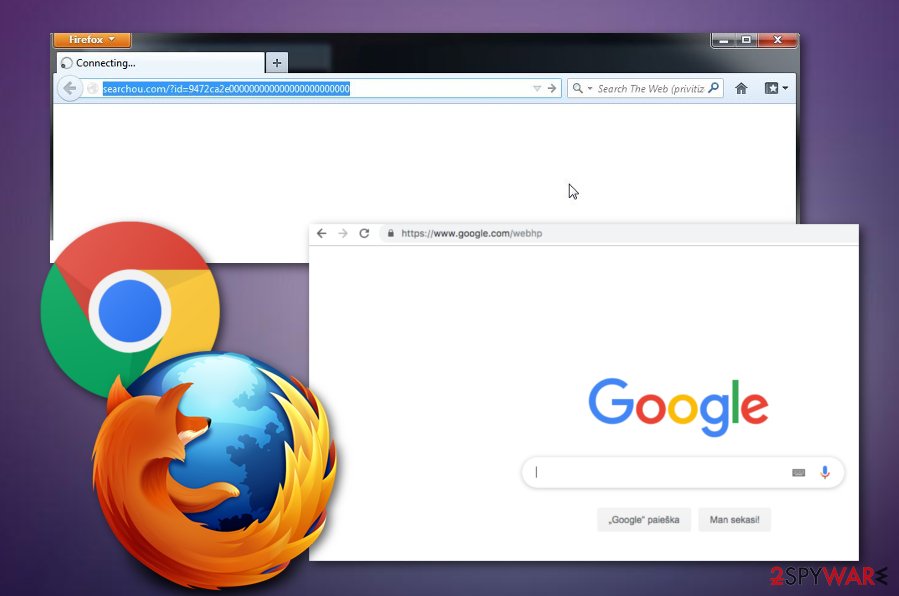Searchou (Easy Removal Guide) - Jul 2019 update
Searchou Removal Guide
What is Searchou?
Searchou – a browser hijacker that can come in a bundle with Privitze VPN

Searchou is described as a browser-hijacking application that enters systems with additional content such as Privitze VPN. Once you end up with this browser hijacker, unpleasant alterings will be spotted by the default search engine, address bar, and homepage modified to google.com/webhp. After Searchou virus places itself on your machine, you can expect several suspicious activities that are going to be carried out in the meantime. Mostly, these PUPs are closely related to redirecting to affiliate websites, placement of advertising content, browser history enhancing, injection of odd extensions, and similar.
| Name | Searchou |
|---|---|
| Type | Browser hijacker |
| Additional software | Privitze VPN which travels with MagniPic |
| Engine | google.com/webhp |
| Found in | thepiratebay.se and other unsecured networks |
| Activities | Alterings of browser settings (engine, homepage, new tab URL) |
| Manual removal | Look for instructions at the end of this page |
| Automatical elimination | Download FortectIntego and try removing the potentially unwanted program with this tool |
Reports about Searchou triggering users have flooded the Internet in the past. You can find Malwarebytes forums wild with reports about this browser-hijacking app. One user has claimed that the modified search settings appear each time while entering web browsers such as Chrome, IE, and the computer has been put in the mode of sluggishness. Besides, the user commented that even reliable anti-malware tools can hardly remove every single component of the hijack.[1]
Another person revealed that Searchou.com appeared after downloading a component from the well-known piracy network – thepiratebay.se. After the unsuccessful download, he received the browser hijacker together with the beforementioned Privitze VPN component. It is considered to be a Virtual Private Network[2] that arrives not only with Searchou but also together with MagniPic (an adware program).
As you can see, Searchou can be easily bundled through third-party networks and come with additional software. However, this might be potentially dangerous as different malware strains (Trojan viruses, ransomware, cryptocurrency miners, worms, etc.) are also put up on piracy sites such as The Pirate Bay. Note that browser hijackers are one of the main ways of how malware reaches computer systems.

Another unpleasant feature of Searchou is redirecting that can be caused to take the user to affiliate websites. This is one of the main ways how third-party developers promote their products, for example, rogue security software. However, in some cases, redirecting actions might relate to landings on malicious websites. This is another way how dangerous infections reach the targetted machine/device.
Continuously, Searchou might be capable of collecting results that relate to your browsing activities. Potentially unwanted programs like this can gather information such as your IP address, type of web browser used, commonly search pages, offers requested, online accounts visited, clicks made on specific ads or hyperlinks, saved bookmarks, and even your geographic location and email address.
Later on, the browser hijacker might pass on all collected details to other parties for income-gaining purposes. Avoid this type of unfair activities by performing Searchou removal. You can try eliminating the threat with tools such as FortectIntego, SpyHunter 5Combo Cleaner, or Malwarebytes. Also, you can find manual instructing steps at the end of the article. These guidelines will help you to clean all web browsers on yourself.
However, to remove Searchou fully, you need to get rid of all additional content that the potentially unwanted program has brought together with it. This includes all beforementioned components such as Privitze VPN or even MagniPic if it appeared also. Furthermore, you should definitely check the browser settings for questionable extensions, plug-ins, or add-ons injected.

Browser-hijacking apps are delivered via third-party networks
There are plenty of unsecured sources lurking out in the cyberspace and many users enter such networks every day. They are known as piracy, adult-themed, gambling, or online-gaming websites. According to experts from LosVirus.es,[3] the lack of security in these sources allows various hackers to plant PUPs and even malware in them. Another popular browser hijacker distribution technique is by using software bundles.
If you are looking for ways to avoid potentially unwanted programs such as browser hijacker or adware, you should:
- Keep a proper distance from third-party websites.
- Stop using services that are not provided by their original developers.
- Avoid downloading programs by using “Quick” modes. Choose “Advanced” instead.
- Install a reputable security tool and keep it regularly updated.
Searchou virus removal tips
You need to remove Searchou from your computer system if this potentially unwanted program appeared on your browser unexpectedly and started altering your browser settings. Remember, the longer you keep this threat on your machine, the worse its activities might get and start intruding you even more.
Searchou removal can be carried out in two ways. You can download a reputable anti-malware tool or you can use the below-provided guidelines to clean web browsers such as Google Chrome, Mozilla Firefox, Internet Explorer, Microsoft Edge, and Safari from questionable extensions and add-ons.
You may remove virus damage with a help of FortectIntego. SpyHunter 5Combo Cleaner and Malwarebytes are recommended to detect potentially unwanted programs and viruses with all their files and registry entries that are related to them.
Getting rid of Searchou. Follow these steps
Uninstall from Windows
Erase suspicious content and programs from Windows. Use these instructions to help you:
Instructions for Windows 10/8 machines:
- Enter Control Panel into Windows search box and hit Enter or click on the search result.
- Under Programs, select Uninstall a program.

- From the list, find the entry of the suspicious program.
- Right-click on the application and select Uninstall.
- If User Account Control shows up, click Yes.
- Wait till uninstallation process is complete and click OK.

If you are Windows 7/XP user, proceed with the following instructions:
- Click on Windows Start > Control Panel located on the right pane (if you are Windows XP user, click on Add/Remove Programs).
- In Control Panel, select Programs > Uninstall a program.

- Pick the unwanted application by clicking on it once.
- At the top, click Uninstall/Change.
- In the confirmation prompt, pick Yes.
- Click OK once the removal process is finished.
Delete from macOS
Remove items from Applications folder:
- From the menu bar, select Go > Applications.
- In the Applications folder, look for all related entries.
- Click on the app and drag it to Trash (or right-click and pick Move to Trash)

To fully remove an unwanted app, you need to access Application Support, LaunchAgents, and LaunchDaemons folders and delete relevant files:
- Select Go > Go to Folder.
- Enter /Library/Application Support and click Go or press Enter.
- In the Application Support folder, look for any dubious entries and then delete them.
- Now enter /Library/LaunchAgents and /Library/LaunchDaemons folders the same way and terminate all the related .plist files.

Remove from Microsoft Edge
Delete unwanted extensions from MS Edge:
- Select Menu (three horizontal dots at the top-right of the browser window) and pick Extensions.
- From the list, pick the extension and click on the Gear icon.
- Click on Uninstall at the bottom.

Clear cookies and other browser data:
- Click on the Menu (three horizontal dots at the top-right of the browser window) and select Privacy & security.
- Under Clear browsing data, pick Choose what to clear.
- Select everything (apart from passwords, although you might want to include Media licenses as well, if applicable) and click on Clear.

Restore new tab and homepage settings:
- Click the menu icon and choose Settings.
- Then find On startup section.
- Click Disable if you found any suspicious domain.
Reset MS Edge if the above steps did not work:
- Press on Ctrl + Shift + Esc to open Task Manager.
- Click on More details arrow at the bottom of the window.
- Select Details tab.
- Now scroll down and locate every entry with Microsoft Edge name in it. Right-click on each of them and select End Task to stop MS Edge from running.

If this solution failed to help you, you need to use an advanced Edge reset method. Note that you need to backup your data before proceeding.
- Find the following folder on your computer: C:\\Users\\%username%\\AppData\\Local\\Packages\\Microsoft.MicrosoftEdge_8wekyb3d8bbwe.
- Press Ctrl + A on your keyboard to select all folders.
- Right-click on them and pick Delete

- Now right-click on the Start button and pick Windows PowerShell (Admin).
- When the new window opens, copy and paste the following command, and then press Enter:
Get-AppXPackage -AllUsers -Name Microsoft.MicrosoftEdge | Foreach {Add-AppxPackage -DisableDevelopmentMode -Register “$($_.InstallLocation)\\AppXManifest.xml” -Verbose

Instructions for Chromium-based Edge
Delete extensions from MS Edge (Chromium):
- Open Edge and click select Settings > Extensions.
- Delete unwanted extensions by clicking Remove.

Clear cache and site data:
- Click on Menu and go to Settings.
- Select Privacy, search and services.
- Under Clear browsing data, pick Choose what to clear.
- Under Time range, pick All time.
- Select Clear now.

Reset Chromium-based MS Edge:
- Click on Menu and select Settings.
- On the left side, pick Reset settings.
- Select Restore settings to their default values.
- Confirm with Reset.

Remove from Mozilla Firefox (FF)
Remove dangerous extensions:
- Open Mozilla Firefox browser and click on the Menu (three horizontal lines at the top-right of the window).
- Select Add-ons.
- In here, select unwanted plugin and click Remove.

Reset the homepage:
- Click three horizontal lines at the top right corner to open the menu.
- Choose Options.
- Under Home options, enter your preferred site that will open every time you newly open the Mozilla Firefox.
Clear cookies and site data:
- Click Menu and pick Settings.
- Go to Privacy & Security section.
- Scroll down to locate Cookies and Site Data.
- Click on Clear Data…
- Select Cookies and Site Data, as well as Cached Web Content and press Clear.

Reset Mozilla Firefox
If clearing the browser as explained above did not help, reset Mozilla Firefox:
- Open Mozilla Firefox browser and click the Menu.
- Go to Help and then choose Troubleshooting Information.

- Under Give Firefox a tune up section, click on Refresh Firefox…
- Once the pop-up shows up, confirm the action by pressing on Refresh Firefox.

Remove from Google Chrome
Clean and refresh your Google Chrome web browser after the browser hijacker has modified it:
Delete malicious extensions from Google Chrome:
- Open Google Chrome, click on the Menu (three vertical dots at the top-right corner) and select More tools > Extensions.
- In the newly opened window, you will see all the installed extensions. Uninstall all the suspicious plugins that might be related to the unwanted program by clicking Remove.

Clear cache and web data from Chrome:
- Click on Menu and pick Settings.
- Under Privacy and security, select Clear browsing data.
- Select Browsing history, Cookies and other site data, as well as Cached images and files.
- Click Clear data.

Change your homepage:
- Click menu and choose Settings.
- Look for a suspicious site in the On startup section.
- Click on Open a specific or set of pages and click on three dots to find the Remove option.
Reset Google Chrome:
If the previous methods did not help you, reset Google Chrome to eliminate all the unwanted components:
- Click on Menu and select Settings.
- In the Settings, scroll down and click Advanced.
- Scroll down and locate Reset and clean up section.
- Now click Restore settings to their original defaults.
- Confirm with Reset settings.

Delete from Safari
Remove unwanted extensions from Safari:
- Click Safari > Preferences…
- In the new window, pick Extensions.
- Select the unwanted extension and select Uninstall.

Clear cookies and other website data from Safari:
- Click Safari > Clear History…
- From the drop-down menu under Clear, pick all history.
- Confirm with Clear History.

Reset Safari if the above-mentioned steps did not help you:
- Click Safari > Preferences…
- Go to Advanced tab.
- Tick the Show Develop menu in menu bar.
- From the menu bar, click Develop, and then select Empty Caches.

After uninstalling this potentially unwanted program (PUP) and fixing each of your web browsers, we recommend you to scan your PC system with a reputable anti-spyware. This will help you to get rid of Searchou registry traces and will also identify related parasites or possible malware infections on your computer. For that you can use our top-rated malware remover: FortectIntego, SpyHunter 5Combo Cleaner or Malwarebytes.
How to prevent from getting browser hijacker
Stream videos without limitations, no matter where you are
There are multiple parties that could find out almost anything about you by checking your online activity. While this is highly unlikely, advertisers and tech companies are constantly tracking you online. The first step to privacy should be a secure browser that focuses on tracker reduction to a minimum.
Even if you employ a secure browser, you will not be able to access websites that are restricted due to local government laws or other reasons. In other words, you may not be able to stream Disney+ or US-based Netflix in some countries. To bypass these restrictions, you can employ a powerful Private Internet Access VPN, which provides dedicated servers for torrenting and streaming, not slowing you down in the process.
Data backups are important – recover your lost files
Ransomware is one of the biggest threats to personal data. Once it is executed on a machine, it launches a sophisticated encryption algorithm that locks all your files, although it does not destroy them. The most common misconception is that anti-malware software can return files to their previous states. This is not true, however, and data remains locked after the malicious payload is deleted.
While regular data backups are the only secure method to recover your files after a ransomware attack, tools such as Data Recovery Pro can also be effective and restore at least some of your lost data.
- ^ Privitize VPN and Searchou malware won't go away. Need help!. Malwarebytes. Technology forums.
- ^ Virtual Private Network. Wikipedia. The free encyclopedia.
- ^ LosVirus.es. LosVirus. Spyware news.























